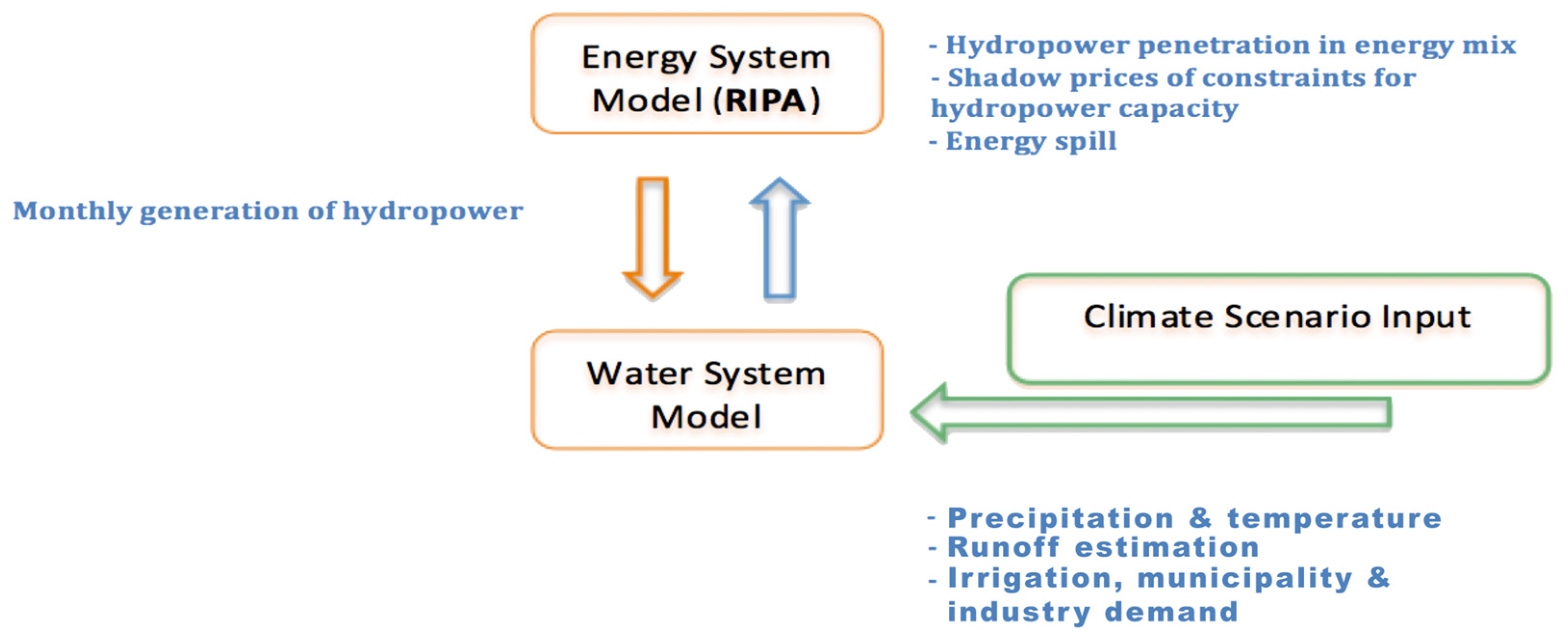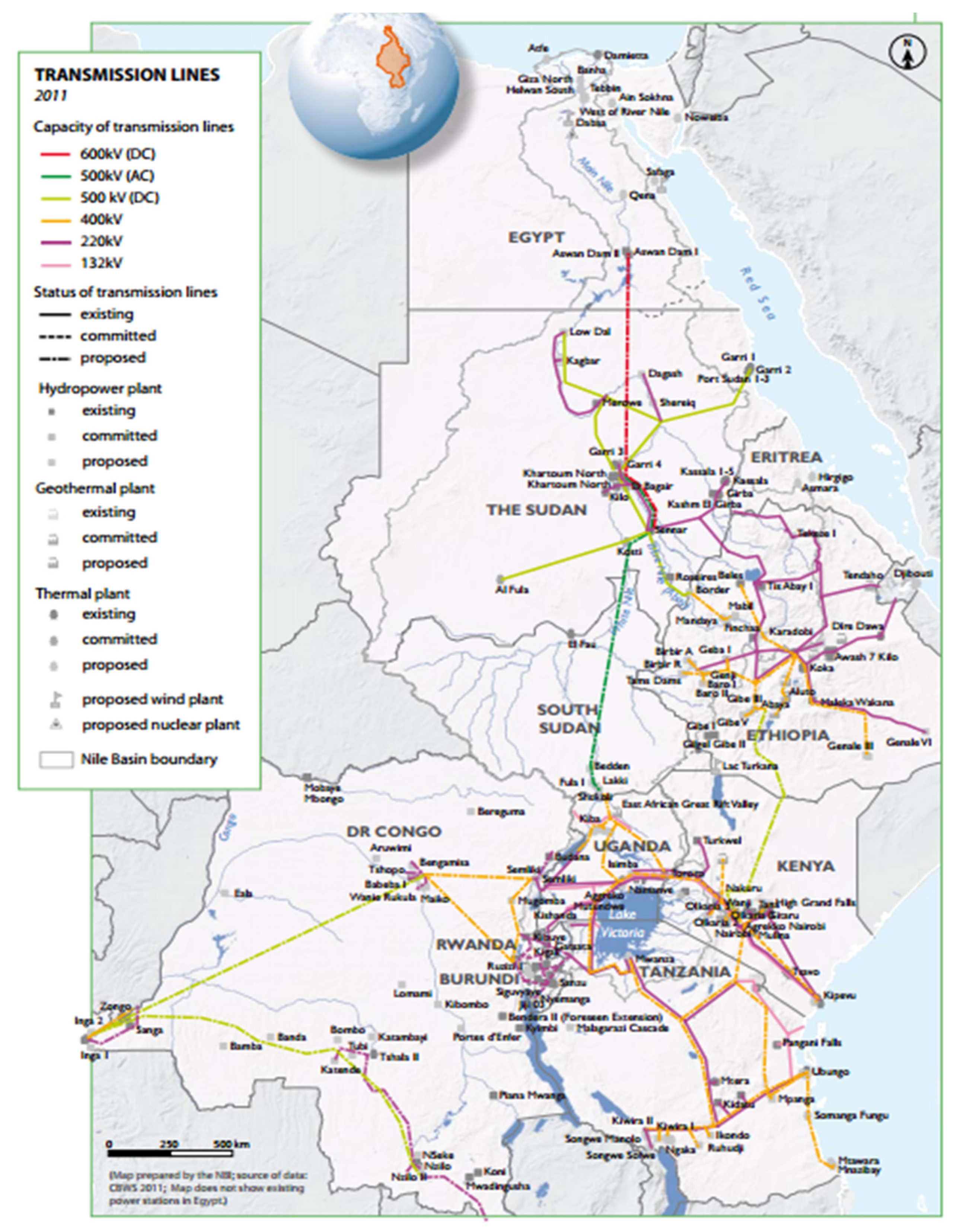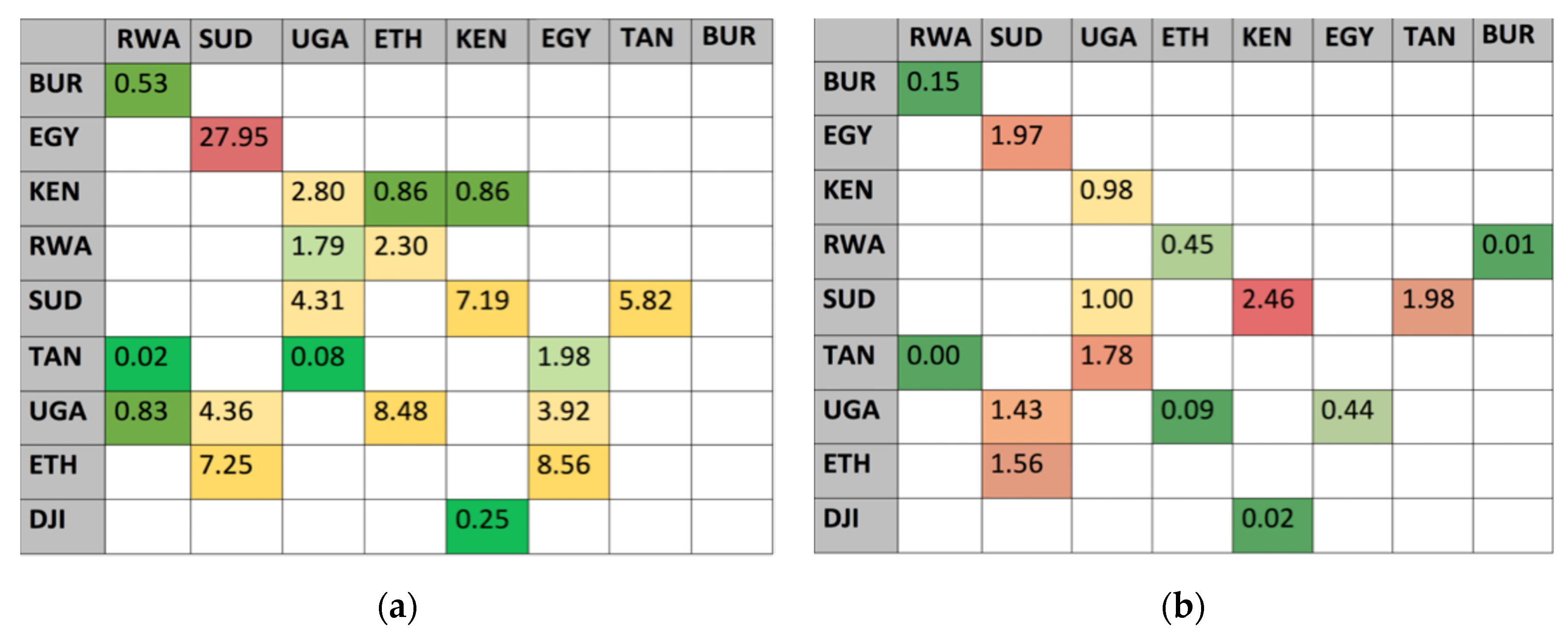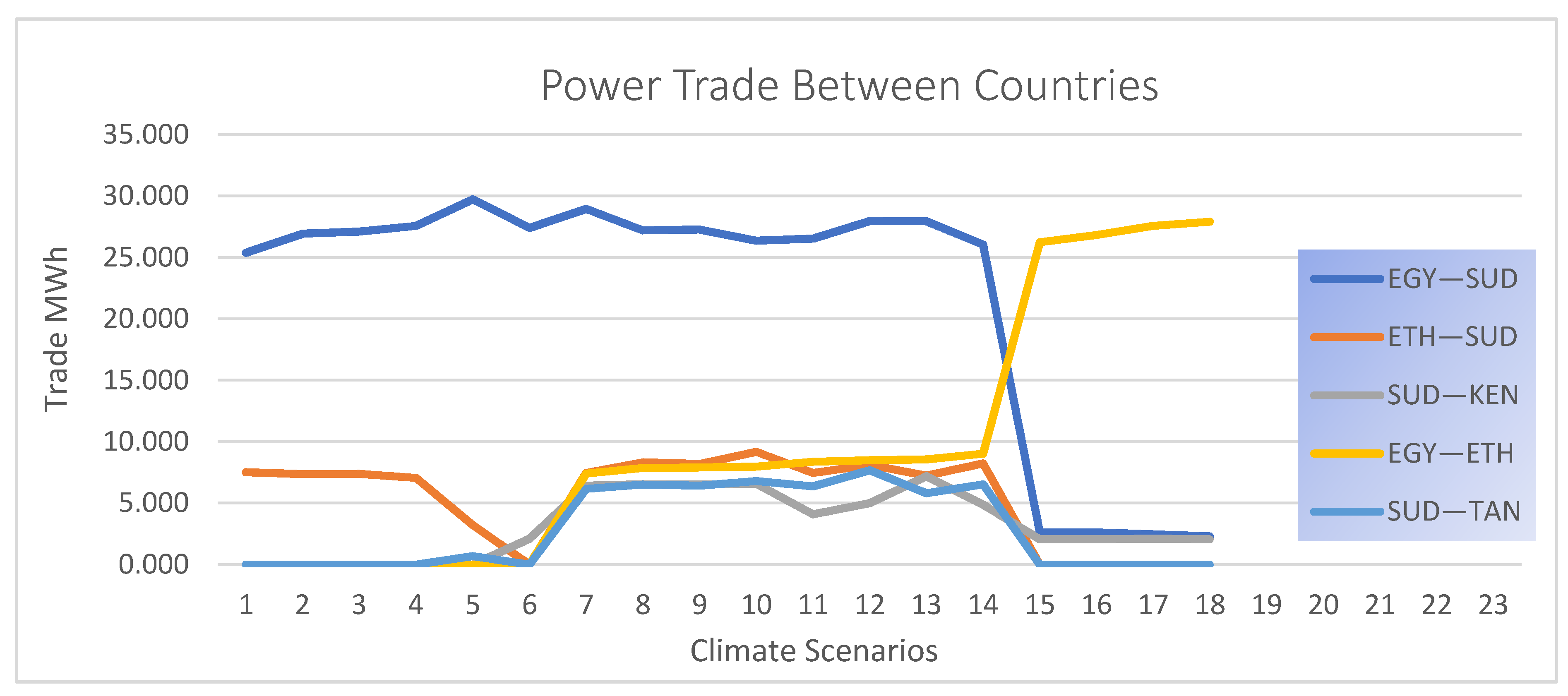Assessment of the Water-Energy Nexus under Future Climate Change in the Nile River Basin
Abstract
:1. Introduction
Literature Review
2. Methods
2.1. Energy and Water System Models
2.1.1. Energy Model
2.1.2. Water Model
2.2. Formulation of Model Coupling
2.3. Climate Scenarios
3. Application of the Model to the Nile River Basin
4. Results
5. Conclusions
Author Contributions
Funding
Data Availability Statement
Acknowledgments
Conflicts of Interest
References
- Nakata, T. Energy-economic models and the environment. Prog. Energy Combust. Sci. 2004, 30, 417–478. [Google Scholar] [CrossRef]
- Pandey, R. Energy policy modelling: Agenda for developing countries. Energy Policy 2002, 30, 97–106. [Google Scholar] [CrossRef]
- Worrel, E.; Ramesohl, S.; Boyd, G. Advances in energy forecasting models based on engineering economic. Annu. Rev. Environ. Resour. 2004, 29, 345–381. [Google Scholar] [CrossRef]
- World Energy Outlook 2012 Home Page. Available online: https://www.iea.org/reports/world-energy-outlook-2012 (accessed on 2 February 2019).
- Degefu, D.M.; He, W.; Zhao, J.H. Hydropower for sustainable water and energy development in Ethiopia. Sustain. Water Resour. Manag. 2015, 1, 305–314. [Google Scholar] [CrossRef] [Green Version]
- Woznicki, S.A.; Nejadhashemi, A.P.; Parsinejad, M. Climate change and irrigation demand: Uncertainty and adaptation. J. Hydrol. Reg. Stud. 2015, 3, 247–264. [Google Scholar] [CrossRef]
- Zeng, R.; Cai, X.; Ringker, C.; Zhu, T. Hydropower versus irrigation—An analysis of global patterns. Environ. Res. Lett. 2017, 12, 034006. [Google Scholar] [CrossRef]
- Fattahi, A.; Sijm, J.; Faaij, A. A Systemic Approach to Analyze Integrated Energy System Modeling Tools: A Review of National Models; Elsevier: Amsterdam, The Netherlands, 2020; Volume 133, p. 110195. [Google Scholar]
- Amaral, L.P.; Martins, N.; Gouveia, J.B. A review of energy theory, its application and latest developments. Renew. Sustain. Energy Rev. 2016, 54, 882–888. [Google Scholar] [CrossRef]
- Hoffman, K.; Wood, D.O. Energy system modelling and forecasting. Annu. Rev. Energy 1976, 1, 423–453. [Google Scholar] [CrossRef]
- Masoumzadeh, A.; Rasekhi, H.; Fathi, H.A. A comprehensive energy supply model in an office building based on the reference energy system. Int. J. Sustain. Energy 2016, 35, 88–102. [Google Scholar] [CrossRef]
- Munasinghe, M.; Meier, P. Energy Policy Analyis and Modelling; Cambridge Books; Cambridge University: Cambridge, UK, 1993. [Google Scholar]
- Hoffman, K.; Jorgenson, D.W. Economic and technological models for evaluation of energy policy. Bell J. Econ. 1977, 8, 444–466. [Google Scholar] [CrossRef]
- Bouffaron, P.; Avrin, A.P. Prospective_Energ_Etique: L’exemple de SWITCH, un mod_ele de Planification du Syst_eme _Electrique Made in UC Berkeley. Bulletins Electroniques Etats-Unis. 2012. Available online: http://www.bulletins-electroniques.com/actualites/71765.htm (accessed on 2 May 2015).
- Herbst, A.; Felipe, T.; Felix, R.; Eberhard, J. Introduction to energy systems modelling. Swiss J. Econ. Stat. 2012, 148, 111–135. [Google Scholar] [CrossRef] [Green Version]
- Hourcade, J.C.; Jaccard, M.; Bataille, C.; Ghersi, F. Hybrid modeling: New answers to old challenges. Energy J. 2006, 21, 12. [Google Scholar]
- Jebaraj, S.; Iniyan, S. A review of energy models. Renew. Sustain. Energy Rev. 2006. [Google Scholar] [CrossRef]
- Van Beeck, N. Classification of Energy Models; Citeseer; School of Economics and Management, Tilburg University: Tilburg, The Netherlands, 1999. [Google Scholar]
- Subhes, C.; Govinda, B.; Timilsina, R. A review of energy system models. Int. J. Energy Sect. Manag. 2010, 4, 494–518. [Google Scholar]
- Welsch, M.; Deane, P.; Howells, M.O.; Gallachóir, B.; Rogan, F.; Bazilian, M.; Rogner, H.H. Incorporating flexibility requirements into long-term energy system models—A case study on high levels of renewable electricity penetration in Ireland. Appl. Energy 2014, 135, 600–615. [Google Scholar] [CrossRef]
- Despres, J. Development of a Dispatch Model of the European Power System for Coupling with a Long-Term Foresight Energy Model; Working Papers hal-01245554; HAL Archive: Lyon, France, 2015. [Google Scholar]
- Després, J.; Hadjsaid, N.; Criqui, P.; Noirot, I. Modelling the impacts of variable renewable sources on the power sector: Reconsidering the typology of energy modeling tools. Energy 2015, 80, 486–495. [Google Scholar] [CrossRef]
- Connolly, D.; Lund, H.; Mathiesen, B.V.; Leahy, M. A review of computer tools for analyzing the integration of renewable energy into various energy systems. Appl. Energy 2010, 87, 1059–1082. [Google Scholar] [CrossRef]
- Pfenninger, S.; Hawkes, A.; Keirstead, J. Energy systems modeling for twenty-first century energy challenges. Renew. Sustain. Energy Rev. 2014, 33, 74–86. [Google Scholar] [CrossRef]
- Sinha, S.; Chandel, S. Review of recent trends in optimization techniques for solar photovoltaic—Wind based hybrid energy systems. Renew. Sustain. Energy Rev. 2015, 50, 755–769. [Google Scholar] [CrossRef]
- Loulou, R.; Labriet, M. ETSAP-TIAM: The TIMES integrated assessment model part I: Model structure. Comput. Manag. Sci. 2008, 5, 7–40. [Google Scholar] [CrossRef]
- Cormio, C.; Dicorato, M.; Minoia, A.; Trovato, M. A regional energy planning methodology including renewable energy sources and environmental constraints. Sustain. Energy Rev. 2003, 7, 99–130. [Google Scholar] [CrossRef]
- Centre for Renewable Energy Sources. Available online: http://www.cres.gr/kape/index_eng.htm (accessed on 21 March 2021).
- ETSAP. MARKAL. IEA ETSAP 2014. Available online: http://www.iea-etsap.org/web/Markal.asp (accessed on 4 February 2021).
- Nakicenovic, N.; Gruebler, A.; McDonald, A. (Eds.) Global Energy Perspectives; Cambridge University Press: Cambridge, UK, 1998. [Google Scholar]
- Rao, S.; Riahi, K. The role of non-CO2 greenhouse gases in climate change mitigation: Long-term scenarios for the 21st century. Energy J. 2006, 27, 177–200. [Google Scholar] [CrossRef]
- Welsch, M. Enhancing the Treatment of Systems Integration in Long-Term Energy Models. Ph.D. Thesis, KTH Royal Institute of Technology, Stockholm, Sweden, 2013. [Google Scholar]
- E3Mlab of ICCS/NTUA. PRIMES Model. 2008. Available online: http://www.e3mlab.ntua.gr/manuals/The_PRIMES_MODEL_2008.pdf (accessed on 5 January 2021).
- Heaps, C.G. Long-Range Energy Alternatives Planning (LEAP) System. 2016. Available online: https://www.energycommunity.org (accessed on 12 March 2021).
- AURORAxmp. Available online: http://epis.com/aurora_xmp/ (accessed on 8 February 2021).
- EPIS. AURORAxmp. Available online: http://epis.com/powermarketinsights/index.php/tag/power-market-modeling// (accessed on 8 February 2021).
- EATON. CYME Power Engineering Software. Available online: http://www.cyme.com/ (accessed on 3 January 2021).
- Stadler, M.; Groissböck, M.; Cardoso, G.; Marnay, C. Optimizing Distributed Energy Resources and building retrofits with the strategic DER-CAModel. Appl. Energy 2014, 132, 557–567. [Google Scholar] [CrossRef] [Green Version]
- EMPS: Multi Area Power-Market Simulator. Available online: https://www.sintef.no/en/software/emps-multi-area-power-market-simulator/ (accessed on 14 February 2021).
- Entertile. Available online: http://www.enertile.eu (accessed on 1 February 2021).
- Energy System Models at Fraunhofer ISE. Available online: http://www.entigris.org (accessed on 17 February 2021).
- PLEXOS Integrated Energy Model. Available online: http://energyexemplar.com/software/plexos-desktop-edition/ (accessed on 9 February 2020).
- Capros, P.; Regemorter, V.D.; Paroussos, L.; Karkatsoulis, P.; Fragkiadakis, C.; Tsani, S.; Charalampidis, I.; Revesz, T. GEM-E3 Model Documentation; JRC Working Papers JRC83177; Joint Research Centre (Seville site): Sevilla, Spain, 2013. [Google Scholar]
- GreenNet. Guiding a Least Cost Grid Integration of RES-Electricity in an Extended Europe. GreenNet-EU 27 n.d. Available online: http://www.greennet-europe.org/ (accessed on 23 December 2020).
- Schafer, A.; Jacoby, H.D. Experiments with a hybrid CGE-MARKAL model. Energy J. 2006, 27, 171–178. [Google Scholar] [CrossRef]
- E3Mlab. GEM-E3 Model Manual 2010. Available online: http://147.102.23.135/e3mlab/GEM%20-%20E3%20Manual/Manual%20of%20GEM-E3.pdf (accessed on 16 October 2020).
- Yang, Z.; Eckaus, R.S.; Ellerman, A.D.; Jacoby, H.D. The MIT Emissions Prediction and Policy Analysis (EPPA) Model; MIT: Cambridge, UK, 1996. [Google Scholar]
- Yates, D.; Purkey, D.; Sieber, J.; Hubber-Lee, A.; Galbraith, H. WEAP21—A Demand-, Priority-, and Preference-Driven Water Planning Model. Water Int. 2005, 30, 487–500. [Google Scholar] [CrossRef]
- Paltsev, S.; Reilly, J.M.; Jacoby, H.D.; Eckaus, R.S.; McFarland, J.R.; Sarofim, M.C.; Asadoorian, M.O.; Babiker, M.H.M. The MIT emissions prediction and policy analysis (EPPA) model: Version 4. In MIT Joint Program on the Science and Policy of Global Change; MIT Joint Program on the Science and Policy of Global Change: Cambridge, MA, USA, 2005. [Google Scholar]
- Lee, H.; Oliveira-Martins, J.; Van der Mensbrugghe, D. The OECD Green Model: An Updated Overview; Organization for Economic Co-Operation and Development: Paris, France, 1994. [Google Scholar]
- Manne, A.S.; Wene, C.O. Markal-Macro: A Linked Model for Energy-Economy Analysis; Brookhaven National Lab.: Upton, NY, USA, 1992. [Google Scholar]
- Lee, K.H.; Lee, D.W.; Baek, N.C.; Kwon, H.M.; Lee, C.J. Preliminary determination of optimal size for renewable energy resources in buildings using RETScreen. Energy 2012, 47, 83–96. [Google Scholar] [CrossRef]
- National Resources Canada. RETScreen International. Available online: http://www.retscreen.net/ (accessed on 19 November 2020).
- POLES: Prospective Outlook on Long-Term Energy Systems. 2017. Available online: https://www.enerdata.net/solutions/poles-model.html (accessed on 12 December 2020).
- Sullivan, P.; Krey, V.; Riahi, K. Impacts of considering electric sector variability and reliability in the MESSAGE model. Energy Strategy Rev. 2013, 1, 157–163. [Google Scholar] [CrossRef]
- McPherson, M.; Karney, B. Long-term scenario alternatives and their implications: LEAP model application of Panama’s electricity sector. Energy Policy 2014, 68, 146–157. [Google Scholar] [CrossRef]
- Global Change Assessment Model—Joint Global Change Research. 2017. Available online: http://www.globalchange.umd.edu/gcam/ (accessed on 10 January 2021).
- ETM Model. Available online: https://www.euro-fusion.org/collaborators/socio-economics/economics/model/ (accessed on 12 February 2021).
- Kanudia, A.; Loulou, R. Robust responses to climate change via stochastic MARKAL: The case of québec. Eur. J. Oper. Res. 1998, 106, 15–30. [Google Scholar] [CrossRef]
- Messner, S.; Golodnikov, A.; Gritsevskii, A. A stochastic version of the dynamic linear programming model MESSAGEIII. Energy 1996, 21, 775–784. [Google Scholar] [CrossRef] [Green Version]
- Panciatici, P.; Campi, M.C.; Garatti, S.; Low, S.H.; Molzahn, D.K.; Sun, A.X.; Wehenkel, L. Advanced optimization methods for power systems. In Proceedings of the 2014 Power Systems Computation Conference, Wroclaw, Poland, 18–22 August 2014. [Google Scholar] [CrossRef] [Green Version]
- Vakilifard, N.; Anda, M.; Bahri, A.P.; Ho, H. The role of water-energy nexus in optimising water supply systems–Review of techniques and approaches. Renew. Sustain. Energy Rev. 2018, 82, 1424–1432. [Google Scholar] [CrossRef]
- Smajgl, A.; Ward, J.; Pluschke, L. Water–food–energy nexus–realising a new paradigm. J. Hydrol. 2016, 533, 533–540. [Google Scholar] [CrossRef]
- Poncelet, K. The Importance of Including Short Term Dynamics in Planning Models for Electricity Systems with High Shares of Intermittent Renewables; IEA-ETSAP Workshop: Beijing, China, 2014. [Google Scholar]
- Haydt, G.; Leal, V.; Pina, A.; Silva, C.A. The relevance of the energy resource dynamics in the mid/long-term energy planning models. Renew. Energy 2011, 36, 3068–3074. [Google Scholar] [CrossRef]
- Jaehnert, S.; Doorman, G. Modelling an Integrated Northern European Regulating Power Market Based on a Common Day-Ahead Market. In Proceedings of the 33rd IAAE’s International Conference, Rio de-Janeiro, Brazil, 6 June 2010. [Google Scholar]
- Mysiak, J.; Giupponi, C.; Rosato, P. Towards the development of a decision support system for water resource management. Environ. Model. Softw. 2005, 20, 203–214. [Google Scholar] [CrossRef]
- Rees, H.G.; Holmes, M.G.R.; Fry, M.J.; Young, A.R.; Pitson, D.G.; Kansakar, S.R. An integrated water resource management tool for the Himalayan region. Environ. Model. Softw. 2006, 21, 1001–1012. [Google Scholar] [CrossRef]
- Li, W.; Abel, A.; Todtermuschke, K.; Zhang, T. Hybrid vehicle power transmission modeling and simulation with simulationX. In Proceedings of the 2007 International Conference on Mechatronics and Automation, Beijing, China, 2–5 August 2007. [Google Scholar]
- Van Cauwenbergh, N.; Pinte, D.; Tilmant, A.; Frances, I.; Pulido-Bosch, A.; Vanclooster, M. Multi-objective, multiple participant decision support for water management in the Andarax catchment, Almeria. Environ. Geol. 2008, 54, 479–489. [Google Scholar] [CrossRef]
- Coelho, A.C.; Labadie, J.W.; Fontane, D.G. Multicriteria decision support system for regionalization of integrated water resources management. Water Resour. Manag. 2012, 26, 1325–1346. [Google Scholar] [CrossRef]
- Gaivoronski, A.A.; Sechi, G.M.; Zuddas, P. Balancing cost-risk in management optimization of water resource systems under uncertainty. Phys. Chem. Earth 2011. [Google Scholar] [CrossRef]
- Al-Omari, A. A methodology for the breakdown of NRW into physical and administrative losses. Water Resour. Manag. 2015, 27, 1913–1930. [Google Scholar] [CrossRef]
- Stockholm Environment Institute, SEI. WEAP (Water Evaluation and Planning): User’s Guide. 2015. Available online: https://www.weap21.org/downloads/WEAP_User_Guide.pdf (accessed on 21 June 2020).
- Marcinek, J. Hydrological cycle and water balance. In Global Change: Enough Water for All; Lozán, J.L., Ed.; Wissenschaftliche Auswertungen: Hamburg, Germany, 2007. [Google Scholar]
- Shumet, A.G.; Mengistu, K.T. Assessing the impact of existing and future water demand on economic and environmental aspects (Case study from Rift Valley Lake Basin: Meki-Ziway Sub Basin), Ethiopia. Int. J. Waste Resour. 2016, 6, 223. [Google Scholar] [CrossRef] [Green Version]
- Koutsoyiannis, D. Hurst-Kolmogorov dynamics and uncertainty. J. Am. Water Resourc. Assoc. 2011, 47, 481–495. [Google Scholar] [CrossRef]
- Hurst, H.E. Long term storage capacities of reservoirs. Trans. Am. Soc. Civ. Eng. 1951, 116, 776–808. [Google Scholar]
- Tyralis, H.; Koutsoyiannis, D. Simultaneous estimation of the parameters of the Hurst- Kolmogorov stochastic process. Stoch. Environ. Res. Risk Assess. 2010. [Google Scholar] [CrossRef]
- Koutsoyiannis, D.; Efstratiadis, A.; Georgakakos, K.P. A stochastic methodological framework for uncertainty assessment of hydroclimatic predictions. Geophys. Res. Abstr. Eur. Geosci. Union 2007, 9, 06026. [Google Scholar]
- Fraedrich, K. Fickian diffusion and Newtonian cooling: A concept for noise induced climate variability with long-term memory? Stoch. Dyn. 2002, 2, 403–412. [Google Scholar] [CrossRef]
- Iliopoulou, T.; Papalexiou, S.M.; Markonis, Y.; Koutsoyiannis, D. Revisiting long-range dependence in annual precipita-tion. J. Hydrol. 2018, 556, 891–900. [Google Scholar] [CrossRef]
- Tsoukalas, I.; Makropoulos, C.; Koutsoyiannis, D. Simulation of Stochastic Processes Exhibiting Any-Range Dependence and Arbitrary Marginal Distributions. Water Resour. Res. 2018, 54, 9484–9513. [Google Scholar] [CrossRef]
- Markonisa, Y.; Moustakisb, Y.; Nasikab, C.; Sychovaa, P.; Dimitriadisb, P.; Hanela, M.; Mácaa, P.; Papalexiouc, S.M. Global estima-tion of long-term persistence in annual river runoff. Adv. Water Resour. 2018, 113, 1–12. [Google Scholar] [CrossRef]
- Dimitriadis, P.; Koutsoyiannis, D.; Iliopoulou, T.; Papanicolaou, P. A global-scale investigation of stochastic similarities in marginal distribution and dependence structure of key hydrological-cycle processes. Hydrology 2021, 8, 59. [Google Scholar] [CrossRef]
- Howells, M.; Rogner, H.; Strachan, N.; Heaps, C.; Huntington, H.; Kypreos, S.; Hughes, A.; Silvereira, S.; Carolis, J.; Bazillian, M.; et al. OSeMOSYS: The Open Source Energy Modeling System An introduction to its ethos, structure and development. Energy Policy 2011, 39, 5858–5870. [Google Scholar] [CrossRef]
- Frevert, D.; Fulp, T.; Zagona, E.; Leavesley, G.; Lins, H. Watershed and River Systems Management Program: Overview of Capabilities. J. Irrig. Drain. Eng. 2006, 132, 92–97. [Google Scholar] [CrossRef] [Green Version]
- Zagona, E.; Nowak, K.; Balaji, R.; Jerla, C.; Prairie, J. Riverware’s Integrated Modeling and Analysis Tools for Long-Term Planning under Uncertainty. Available online: https://acwi.gov/sos/pubs/2ndJFIC/Contents/10F_ZagonaNowak_03_01_10.pdf (accessed on 24 January 2021).
- Dale, L.L.; Karali, N.; Millstein, D.; Carnail, M.; Vicuña, S.; Borchers, N.; Bustos, E.; O’Hagan, J.; Purkey, D.; Heaps, C.; et al. An integrated assessment of water-energy and climate change in Sacramento, California: How strong is the nexus? Clim. Chang. 2015, 132, 223–235. [Google Scholar] [CrossRef] [Green Version]
- Howells, M.; Hermann, S.; Welsch, M.; Bazilian, M.; Segerström, R.; Alfstad, T.; Gielen, D.; Rogner, H.; Fischer, G.; van Velthuizen, H.; et al. Integrated analysis of climate change, land-use, energy and water strategies. Nat. Clim. Chang. 2013, 3, 621–626. [Google Scholar] [CrossRef]
- Programme for Infrastructure Development in Africa (PIDA). African Development Bank Home Page. Available online: https://www.afdb.org/en/topics-and-sectors/initiatives-partnerships/programme-for-infrastructure-development-in-africa-pida (accessed on 26 February 2021).
- Bussieck, M.R.; Meeraus, A. Modeling Languages in Mathematical Optimization. In The General Algebraic Modeling System (GAMS); Kallrath, J., Ed.; Springer: Boston, MA, USA, 2004; Volume 88, pp. 137–157. [Google Scholar]
- Bussieck, R.M.; Drud, S.A.; Meeraus, A.A. MINLPLib—A collection of test models for mixed-integer nonlinear programming. Inf. J. Comput. 2003, 15, 114–119. [Google Scholar] [CrossRef] [Green Version]
- Lin, F.T. A genetic algorithm for linear programming with fuzzy constraints. J. Inf. Sci. Eng. 2008, 24, 801–817. [Google Scholar]
- Li, Y.P.; Huang, G.H.; Guo, P.; Nie, S.L. Interval-fuzzy possibilistic mixed integer linear programming for environmental management under uncertainty. Int. J. Environ. Pollut 2010, 42, 93–102. [Google Scholar] [CrossRef]
- Schlosser, C.A.; Strzepek, K.; Fant, C.; Blanc, J.; Paltsev, S.; Jacoby, H.; Reilly, J.; Gueneau, A. The future of global water stress: An integrated assessment. Earth’s Future 2014, 2, 341–361. [Google Scholar] [CrossRef]
- Sokolove, A.P.; Stone, P.H.; Forest, C.E.; Prinn, R.; Sarofim, M.C.; Webster, M.; Paltsev, S.; Schlosser, C.A.; Kickighter, D.; Dutkiewkz, D.; et al. Probabilistic Forecast for Twenty-First-Century Climate Based on Uncertainties in Emissions (without Policy) and Climate Parameters. J. Clim. 2009, 22, 5175–5204. [Google Scholar] [CrossRef] [Green Version]
- Webster, M.; Sokolov, P.A.; Reilly, M.J.; Forest, E.C.; Paltsev, S.; Schlosser, A.; Wang, C.; Kicklighter, D.; Sarofim, M.; Melillo, J.; et al. Analysis of climate policy targets under uncertainty. Clim. Chang. 2012, 112, 569–583. [Google Scholar] [CrossRef] [Green Version]
- Hulme, M. Rainfall Changes in Africa: 1931–1960 to 1961–1990. Int. J. Clim. 1992, 12, 685–699. [Google Scholar] [CrossRef]
- Hulme, M. Global warming. Sage J. 1994, 18, 401–410. [Google Scholar] [CrossRef]
- Hulme, M.; Osborn, T.J.; Johns, T.C. Precipitation Sensitivity to Global Warming: Comparison of Observations with HADMCM2 Simulations. Geophys. Res. Lett. 1998, 25, 3379–3382. [Google Scholar] [CrossRef]
- Michel, D.T.; Carter, R.T.; Jones, D.P.; Hulme, M.; New, M. A comprehensive set of high-resolution grids of monthly climate for Europe and the globe: The observed record (1901–2000) and 16 scenarios (2001–2100). In Tydall Center for Climate Change Research Working Paper; University of East Anglia: Norwich, UK, 2004; Volume 55. [Google Scholar]
- Hielsen, S.S.; Hanse, E. Numerical simulation of rainfall–runoff process on daily basis. Nord. Hydrol. 1973, 4, 171–190. [Google Scholar] [CrossRef]
- Economic Consulting Associates (ECA). The potential of Regional Power Sector Integration: Nile Basin Initiative (NBI) Transmission and Trading Case Study; ECA: London, UK, 2009. [Google Scholar]
- Sridharan, V.; Broad, O.; Shivakumar, A.; Howells, M.; Boehlert, B.; Groves, D.G.; Rogner, H.H.; Taliotis, C.; Neumann, J.E.; Strzepek, K.M.; et al. Resilience of the Eastern African electricity sector to climate driven changes in hydropower generation. Nat. Commun. 2019, 10, 302. [Google Scholar] [CrossRef] [PubMed] [Green Version]
- Nile Basin Initiative (NBI) Hydropower Potential and The Region’s Rising Energy Demand. Available online: http://sob.nilebasin.org/pdf/Chapter%206%20Hydropower.pdf (accessed on 12 March 2021).
- Nile Basin Initiative (NBI) Hydropower Generation Potential. Available online: https://atlas.nilebasin.org/treatise/hydropower-generation-potential/ (accessed on 12 March 2021).
- Nile Basin Initiative (NBI). State of the Nile River Basin Report; NBI: Entebbe, Uganda, 2012; pp. 1–18. [Google Scholar]
- Siam, M.S.; Eltahir, E.A.B. Climate Change enhances interannual variability of the Nile River flow. Nat. Clim. Chang. 2017, 7, 350–354. [Google Scholar]
- Fischer, G.; Shah, M.; Van Velthuizen, H. Climate Change and Agricultural Vulnerability; IIASA: Laxenburg, Austria, 2012. [Google Scholar]






| Year | Burundi | Djibouti | Egypt | Ethiopia | Kenya | Rwanda | Sudan | Tanzania | Uganda |
|---|---|---|---|---|---|---|---|---|---|
| 2010–2015 | 37 | 0 | 2250 | 1070 | 733 | 77 | 1727 | 561 | 830 |
| 2015–2020 | 103 | 0 | 2275 | 6182 | 733 | 148 | 1841 | 598 | 1660 |
| 2021–2025 | 103 | 0 | 2282 | 9677 | 733 | 225 | 2665 | 623 | 2444 |
| 2025–2030 | 103 | 0 | 2282 | 13,862 | 733 | 278 | 3301 | 623 | 2501 |
| 2030–2035 | 97 | 0 | 2282 | 13,862 | 733 | 278 | 3597 | 623 | 2501 |
Publisher’s Note: MDPI stays neutral with regard to jurisdictional claims in published maps and institutional affiliations. |
© 2021 by the authors. Licensee MDPI, Basel, Switzerland. This article is an open access article distributed under the terms and conditions of the Creative Commons Attribution (CC BY) license (https://creativecommons.org/licenses/by/4.0/).
Share and Cite
Yimere, A.; Assefa, E. Assessment of the Water-Energy Nexus under Future Climate Change in the Nile River Basin. Climate 2021, 9, 84. https://doi.org/10.3390/cli9050084
Yimere A, Assefa E. Assessment of the Water-Energy Nexus under Future Climate Change in the Nile River Basin. Climate. 2021; 9(5):84. https://doi.org/10.3390/cli9050084
Chicago/Turabian StyleYimere, Abay, and Engdawork Assefa. 2021. "Assessment of the Water-Energy Nexus under Future Climate Change in the Nile River Basin" Climate 9, no. 5: 84. https://doi.org/10.3390/cli9050084






